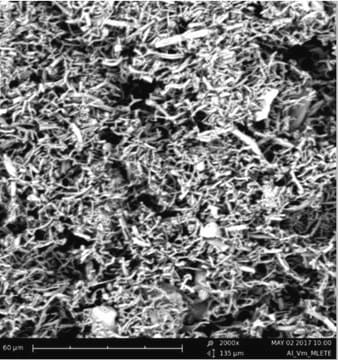E64-RO
Roche
E-64
N-[N-(L-3-Trans-carboxirane-2-carbonyl)-L-leucyl]-agmatine
Synonym(e):
trans-Epoxysuccinyl-L-leucylamido(4-guanidino)butan, L-trans-3-Carboxyoxiran-2-carbonyl-L-leucylagmatin, N-(trans-Epoxysuccinyl)-L-leucin-4-guanidinobutylamid
About This Item
Empfohlene Produkte
Qualitätsniveau
Assay
>95% (HPLC)
Form
powder
Mol-Gew.
Mr 357.4
Verpackung
pkg of 10 mg (10874523001)
pkg of 25 mg (11585681001)
Hersteller/Markenname
Roche
pH-Bereich
2-10
Löslichkeit
ethanol: water (1:1): soluble 20 mg/mL
Lagertemp.
2-8°C
SMILES String
CC(C)C[C@H](NC(=O)[C@@H]1O[C@H]1C(O)=O)C(=O)NCCCCNC(N)=N
InChI
1S/C15H27N5O5/c1-8(2)7-9(20-13(22)10-11(25-10)14(23)24)12(21)18-5-3-4-6-19-15(16)17/h8-11H,3-7H2,1-2H3,(H,18,21)(H,20,22)(H,23,24)(H4,16,17,19)/t9-,10+,11+/m0/s1
InChIKey
LTLYEAJONXGNFG-HBNTYKKESA-N
Suchen Sie nach ähnlichen Produkten? Aufrufen Leitfaden zum Produktvergleich
Verwandte Kategorien
Spezifität
Anwendung
It has been used in the affinity chromatography for the purification of hemoglobin receptors.
The inhibition of thiol proteases by E-64 appears to be of a non-competitive nature between the SH components. The inhibition is also irreversible, and is altered after gel filtration (Sephadex column) or dialysis after incubation of papain with E-64. The enzyme and inhibitor combine in an equimolar ratio.
Biochem./physiol. Wirkung
Angaben zur Herstellung
Working solution: Soluble to 20 mg/ml (stock solution) in a 1:1 (v/v) mixture of ethanol and water (vortexing or slight warming in water bath (40 °C) may facilitate dissolution). Also soluble in a neutral water/methanol solution, in water, methanol, acetic acid, pyridine and DMSO. Sparingly soluble in ethanol and propanol. Insoluble in acetone, chloroform, ethyl ether and benzene.
Storage conditions (working solution): -15 to -25 °C
Solutions are stable for one month when stored in aliquots at -15 to -25 °C.
Rekonstituierung
Sonstige Hinweise
Signalwort
Warning
H-Sätze
Gefahreneinstufungen
STOT SE 2
Lagerklassenschlüssel
11 - Combustible Solids
WGK
WGK 2
Flammpunkt (°F)
does not flash
Flammpunkt (°C)
does not flash
Analysenzertifikate (COA)
Suchen Sie nach Analysenzertifikate (COA), indem Sie die Lot-/Chargennummer des Produkts eingeben. Lot- und Chargennummern sind auf dem Produktetikett hinter den Wörtern ‘Lot’ oder ‘Batch’ (Lot oder Charge) zu finden.
Besitzen Sie dieses Produkt bereits?
In der Dokumentenbibliothek finden Sie die Dokumentation zu den Produkten, die Sie kürzlich erworben haben.
Unser Team von Wissenschaftlern verfügt über Erfahrung in allen Forschungsbereichen einschließlich Life Science, Materialwissenschaften, chemischer Synthese, Chromatographie, Analytik und vielen mehr..
Setzen Sie sich mit dem technischen Dienst in Verbindung.








